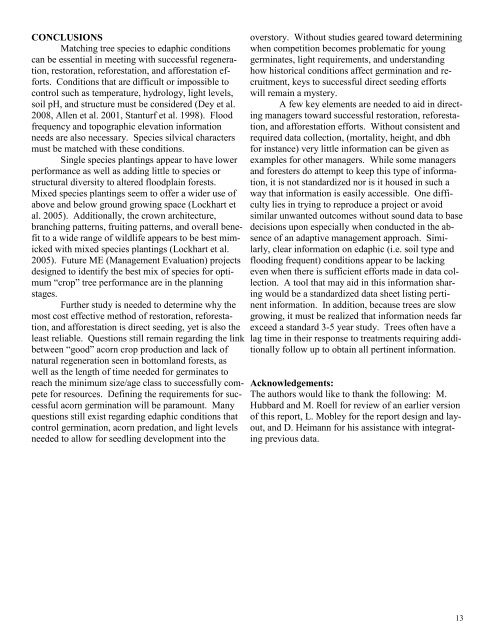Science and Management Technical Series_vol1_final.pdf - Upper ...
Science and Management Technical Series_vol1_final.pdf - Upper ...
Science and Management Technical Series_vol1_final.pdf - Upper ...
Create successful ePaper yourself
Turn your PDF publications into a flip-book with our unique Google optimized e-Paper software.
CONCLUSIONS<br />
Matching tree species to edaphic conditions<br />
can be essential in meeting with successful regeneration,<br />
restoration, reforestation, <strong>and</strong> afforestation efforts.<br />
Conditions that are difficult or impossible to<br />
control such as temperature, hydrology, light levels,<br />
soil pH, <strong>and</strong> structure must be considered (Dey et al.<br />
2008, Allen et al. 2001, Stanturf et al. 1998). Flood<br />
frequency <strong>and</strong> topographic elevation information<br />
needs are also necessary. Species silvical characters<br />
must be matched with these conditions.<br />
Single species plantings appear to have lower<br />
performance as well as adding little to species or<br />
structural diversity to altered floodplain forests.<br />
Mixed species plantings seem to offer a wider use of<br />
above <strong>and</strong> below ground growing space (Lockhart et<br />
al. 2005). Additionally, the crown architecture,<br />
branching patterns, fruiting patterns, <strong>and</strong> overall benefit<br />
to a wide range of wildlife appears to be best mimicked<br />
with mixed species plantings (Lockhart et al.<br />
2005). Future ME (<strong>Management</strong> Evaluation) projects<br />
designed to identify the best mix of species for optimum<br />
―crop‖ tree performance are in the planning<br />
stages.<br />
Further study is needed to determine why the<br />
most cost effective method of restoration, reforestation,<br />
<strong>and</strong> afforestation is direct seeding, yet is also the<br />
least reliable. Questions still remain regarding the link<br />
between ―good‖ acorn crop production <strong>and</strong> lack of<br />
natural regeneration seen in bottoml<strong>and</strong> forests, as<br />
well as the length of time needed for germinates to<br />
reach the minimum size/age class to successfully compete<br />
for resources. Defining the requirements for successful<br />
acorn germination will be paramount. Many<br />
questions still exist regarding edaphic conditions that<br />
control germination, acorn predation, <strong>and</strong> light levels<br />
needed to allow for seedling development into the<br />
overstory. Without studies geared toward determining<br />
when competition becomes problematic for young<br />
germinates, light requirements, <strong>and</strong> underst<strong>and</strong>ing<br />
how historical conditions affect germination <strong>and</strong> recruitment,<br />
keys to successful direct seeding efforts<br />
will remain a mystery.<br />
A few key elements are needed to aid in directing<br />
managers toward successful restoration, reforestation,<br />
<strong>and</strong> afforestation efforts. Without consistent <strong>and</strong><br />
required data collection, (mortality, height, <strong>and</strong> dbh<br />
for instance) very little information can be given as<br />
examples for other managers. While some managers<br />
<strong>and</strong> foresters do attempt to keep this type of information,<br />
it is not st<strong>and</strong>ardized nor is it housed in such a<br />
way that information is easily accessible. One difficulty<br />
lies in trying to reproduce a project or avoid<br />
similar unwanted outcomes without sound data to base<br />
decisions upon especially when conducted in the absence<br />
of an adaptive management approach. Similarly,<br />
clear information on edaphic (i.e. soil type <strong>and</strong><br />
flooding frequent) conditions appear to be lacking<br />
even when there is sufficient efforts made in data collection.<br />
A tool that may aid in this information sharing<br />
would be a st<strong>and</strong>ardized data sheet listing pertinent<br />
information. In addition, because trees are slow<br />
growing, it must be realized that information needs far<br />
exceed a st<strong>and</strong>ard 3-5 year study. Trees often have a<br />
lag time in their response to treatments requiring additionally<br />
follow up to obtain all pertinent information.<br />
Acknowledgements:<br />
The authors would like to thank the following: M.<br />
Hubbard <strong>and</strong> M. Roell for review of an earlier version<br />
of this report, L. Mobley for the report design <strong>and</strong> layout,<br />
<strong>and</strong> D. Heimann for his assistance with integrating<br />
previous data.<br />
13


